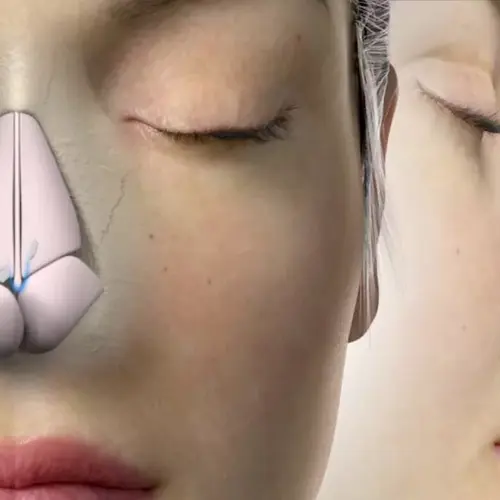The deviation of nasal septum - a disease that causes nasal breathing disorders

Author: Dr. İsmayıl İ. Category: Nose
Published: 2022 - 28 - Sep
Nasal breathing is a physiological process that occurs automatically and is necessary for a person for many factors. In addition to nasal breathing, there is also mouth breathing, which is not physiological and can lead to many chronic diseases of the upper respiratory tract. The nasal cavity performs a number ofA important functions for the body, due to which nasal breathing is more physiological. The air that passes through the nasal cavity is humidified (dry, unmoistened air dries out the mucous membrane of the upper respiratory tract, making it defenseless against many harmful environmental factors), warms up (cold, not warmed inhaled air can cause inflammatory diseases of the upper respiratory tract), and is cleared of harmful impurities and many pathogens (unpurified air often leads to various, including infectious, diseases of the upper respiratory tract). In addition, due to the resonator function of the nasal cavity and paranasal sinuses, with free nasal breathing, a characteristic voice timbre is provided that is characteristic of everyone. Disturbed nasal breathing can lead to a number of pathological conditions both in the upper respiratory tract and throughout the body as a whole. There are a lot of diseases that lead to impaired nasal breathing, but the most common is the curvature of the nasal septum.
PARTITION OF THE NOSE - ANATOMY
The nasal septum is located in the nasal cavity, which is a prism consisting of four walls: lateral (lateral - right and left), upper and lower. The septum is in the middle position and divides the nasal cavity into two parts: right and left. In fact, the nasal septum is almost never strictly in the midline (according to various sources, about 95% of the population has a deviated nasal septum to some extent) and therefore the two halves of the nasal cavity cannot be the same size. The nasal septum consists of two parts: cartilage and bone. The cartilaginous section is the anterior part of the nasal septum and can be felt with your fingers in your nose. This part is responsible for the formation of the external nose along with the nasal bones. The cartilaginous part of the septum is soft, unlike the bone part. This part of the nasal septum is more prone to injury. Fractures of the cartilaginous part are possible, followed by a strong curvature, dislocation or subluxation is possible. The nasal septum is formed by the age of 10, but the final development continues until the age of 15-16.
CAUSES
Depending on the causes, various types of curvature of the nasal septum are divided: physiological, traumatic and compensatory.
- Physiological curvature - occurs due to the fact that the nasal septum consists of bone and cartilage tissues, and the growth rate of these tissues is different: cartilage tissue grows much faster. And if we take into account that the surrounding frame of the nasal septum also consists of bone tissue, it becomes clear that the greatly enlarged nasal septum does not fit in the nasal cavity and begins to bend. Physiological curvature is the most common curvature. As a rule, with this curvature, a displacement from the midline of the nasal septum is observed along almost the entire length of the septum and the formation of ridges and spikes. In addition, frequent inflammatory diseases of the nasal cavity can also contribute to the strengthening of the curvature of the nasal septum.
- Traumatic curvatures are also not uncommon and are the result of mechanical ones: a blow with a hard object, a fall on the nose, and so on. Here, variants of the curvature of the nasal septum are possible without or with a fracture of the bones of the nose. In the first case, a change in the shape of the external nose is not necessary (although, often a violation of the shape of the nose is observed in this case), and in the second case (with a fracture of the bones of the nose), a change in the shape of the external nose is observed. A nose injury can also be observed at the birth of a child. In this case, there may be a dislocation of the cartilage of the nasal septum. In addition, in children, even a minor traumatic impact on the nose can lead to disruption of the growth direction of the nasal septum and subsequently cause significant deformation of the septum.
- Compensatory curvature - when the cause of the curvature is various pathological conditions and diseases in the nasal cavity: polypous rhinosinusitis, foreign bodies of the nasal cavity, vasomotor rhinitis, allergic rhinitis, papilloma of the nasal cavity, and so on.
CLINICAL MANIFESTATIONS
1. Difficulty in nasal breathing. The degree of nasal breathing impairment can vary, from slight discomfort during exercise to almost complete absence of breathing through the nose. Nasal breathing can be impaired both on one side and on both sides
2. Snoring. Disturbed nasal breathing is a very common cause of snoring.
3. Dryness in the nasal cavity. A deviated nasal septum often leads to subatrophy of the nasal mucosa and, as a rule, to dryness as a result.
You can read more about the symptoms and complications of nasal septum here